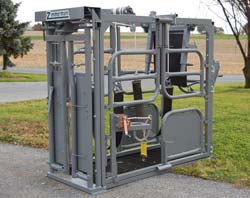Hooves to the chest make breathtaking case for restraint
By Mid-Maryland dairy Veterinarians
Hagerstown, Md. • Phone 301-791-9525
No air was moving. I was hanging from a gate, gasping like a fish out of water, trying to breathe, and no air was moving. Nothing in and nothing out. It happened so fast, one minute I was trying to palpate a cow, the next thing I saw was her hocks above my head and I heard a loud bang. Suddenly I was sagging on a gate passing through the shades of blue and purple trying to breathe.
Dimly, I was aware she had kicked me but I wasn’t sure where or how hard. Whoosh, my first breath came in, and I started to pink up again, but that is when it started to hurt. And it hurt for a long while. Both feet had connected with the bottom of my rib cage in a classic “mule kick”. I could tell from the soiled foot prints on the front of my coveralls. The blow was timed perfectly and the 4-year old Holstein was able to get good extension across the gutter in the stanchion barn. She gave it everything she had.
There were warning signs. She shifted nervously beforehand, her tail was buzzing like a rattlesnake, back and forth, and she made several rapid jumps side to side. I thought I was being careful, I knew she had an attitude. Wham!
The Best Way to get Your Cow Ignored
Cows are big animals. Anyone who has sold some older open cows know Holsteins can and do cross the one-ton mark. For sure, 2000-pound or even just 200-pound upset Holsteins can cause severe damage to facilities, milking equipment, and people. Yet so often we veterinarians are called to farms to examine animals with no possible way of restraining that animal. Fortunately, most cows are cooperative, but many are not. I can state with good certainty that a fractious cow at the end of a halter will not receive the same thorough physical exam a tame cow would get.
Very few things veterinarians do with cows would be considered “pleasant” to the cow. We poke and prod, flick hard all over their sides, perform rectal palpation, stab needles into them, or even perform standing surgery. We are complete strangers. They don’t know why we are doing the things we are doing; all they know isthis guy (or girl) is annoying them and they want it to stop.
Got Restraint?
Good restraint basically holds a cow in place, allows access to both sides, head, rear, udder, and legs, while also providing a degree of safety to the operator . It also provides protection from the weather (including wind), is well lit, and hopefully would have a power source. Head-locks and palpation rails are good restraint for herd activities like pregnancy checking or dry treating.
But a good chute is needed for individual cow work. A good chute, that you can get a cow into, is even more important. I recently spent a lot of time trying to push a cow into a poorly placed chute. I was backing into her so hard, her back feet came off the ground. The only thing we accomplished was she used my back for toilet paper . We still ended up tying her with a halter to a pipe. It was a nice
chute that cost a good chunk of money, but it was useless because we couldn’t get a cow into it.
A Good Chute is Hard to Find
There are many styles and types of chutes available. Fitting chutes are too flimsy for this role. I personally like the Zimmerman chute that is also used for stand up foot trimming. It has a self-locking head catch, four doors on each side (two high and two low) that can be opened independently and a rear gate. It has a belly band and a safe and easy way to pick up individual feet.

I have also seen many home-made chutes made of gates attached to a head lock with the side pipes fitted into “sleeves” so some or all could be removed depending on what needed to be done. Whatever the chute, it has to be fast, easy, and it has to work.
More and more farmers or herdsmen are doing the individual animal care. From past experience, even with good intentions, if it is not easy to do, it won’t get done. Pumping oral fluids into cows is one of the most effective, cheap, and difference making treatments farmers can do for sick cattle. It is so much easier to do in a good chute than tied with a halter in the front of the parlor
where she flops around and fights the whole procedure. Which case do you think would get repeated care?
It Saves Time & Money. Everyone Wins.
“But Doc, those chutes are expensive.” I guarantee you have more money tied up in cows. Good restraint enables you to head off problems faster because it is easy to do. If we can keep three to six cows from going out the door because of prompt effective treatment, the chute has paid for itself. I know treatment outcomes are more successful. I can’t fix a LDA as well when the cow keeps trying to put her foot in my pocket. It saves time and money. Everyone wins.
Reprinted with permission from Farmshine, April 1 issue.
Zimmerman is part of PBZ LLC, which does all our metal fabrication, including tube cutting done by its laser pipe cutting division. Our powder coating is done by brother company Keystone Koating.
|